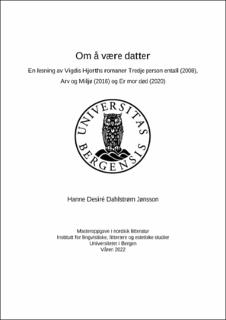| dc.contributor.author | Jønsson, Hanne Desiré Dahlstrøm | |
| dc.date.accessioned | 2022-06-24T00:02:06Z | |
| dc.date.available | 2022-06-24T00:02:06Z | |
| dc.date.issued | 2022-05-20 | |
| dc.date.submitted | 2022-06-23T22:01:08Z | |
| dc.identifier.uri | https://hdl.handle.net/11250/3000420 | |
| dc.description.abstract | Denne masteroppgaven er et motivstudie av den kompliserte mor-datter-relasjonen i Vigdis Hjorths romaner Tredje person entall (2008), Arv og miljø (2016) og Er mor død (2020). Gjennom en nærlesning av romanene undersøker jeg hvordan det ambivalente forholdet mellom mor og datter, blir fremstilt fra et datterperspektiv i romanene. Jeg undersøker følgende forskningsspørsmål: Hva sier døtrene om mor-datter-relasjonen? Hvordan kan man tolke forholdet mellom mor og datter i lys av eksisterende psykoanalytisk og feministisk teori, og kommenterer romanene eventuelt teorien? Endrer fremstillingen av mor-datter-relasjonen seg i løpet av disse tre romanene? Narratologisk undersøkelse av forteller viser at datteren er den fortellende instansen i alle tre romanene. Teoretisk anvender jeg psykoanalysen, fordi denne er utgangspunktet for flere forskeres arbeid og undersøkelser av døtre og mødre. Psykoanalysen er også vesentlig for Hjorth, og hennes romanpersoner. Jeg bruker Sigmund Freuds teorier om Ødipuskomplekset som utgangspunkt, samt teori skrevet av et utvalg av ulike feministiske forskere, som har undersøkt døtre og mødre. Oppgavens analyser viser at Hjorth skildrer kompliserte og ambivalente mor-datter-forhold i Tredje person entall, Arv og miljø og Er mor død. I lesningen har jeg blant annet kommentert døtrenes ønske om frigjøring, deres negative identifikasjon med mødrene, betroelser og allianser, moderskap, melankoli og skaperkraft. Vigdis Hjorth har mye kunnskap om eksisterende psykoanalytisk og feministisk teori, som skinner gjennom i litteraturen hennes. Romanene kommenterer derfor både direkte og indirekte psykoanalytisk teori. Psykoanalytisk teori, og Hjorths romaner, har vist at jenter har vanskeligheter med differensiering og individualisering, og derfor også har vanskeligheter med løsrivelsesprosessen. Analysene argumenterer for at alle tre døtrene er ambivalente i forhold til om de er frigjort eller ikke. Hjorth viser hvilken betydning datterens forhold til moren har for datterens utvikling og liv. Man kan ikke generalisere og lese mor-datter-forholdene i romanene normativt. Hjorth skildrer negative, kompliserte og ambivalente mor-datter-forhold, som kommenterer og samsvarer med psykoanalytisk teori. | |
| dc.description.abstract | This master thesis is a motif study of the complicated mother-daughter relationship in Vigdis Hjorth’s novels Tredje person entall (2008), Arv og miljø (2016) and Er mor død (2020). Through the reading of the novels I examine how the ambivalent relationship between mother and daughter is portrayed from a daughters perspective. The daughter is the narrating instance in all three novels. I examine the following questions: What do the daughters say about the mother-daughter relationship? How can one interpret the relationship between mother and daughter in the light of existing psychoanalytic and feminist theory, and do the novels comment on any theories? Does the portrayal of the mother-daughter relationship change during these three novels? Theoretically, I use psychoanalysis, because this is relevant for several researchers work and studies on daughters and mothers. Psychoanalysis is also important to Hjorth, and her novel characters. I use Sigmund Freud’s theories about the Oedipus complex as a starting point, as well as theory written by a selection of feminist researchers, who have studied daughters and mothers. My analysis shows that Hjorth portrays complicated and ambivalent mother-daughter relationships in Tredje person entall, Arv og miljø and Er mor død. In the analysis I have commented on the daughters desire for liberation, the daughters negative identification with their mother, confidences and alliances, motherhood and melancholy. Vigdis Hjorth has a lot of knowledge about existing psychoanalytic and feminist theory, which she interprets in her literature. The novels comment both directly and indirectly on psychoanalytic theory. Psychoanalytic theory, and Hjorth’s novels, have shown that girls have difficulties with differentiation and individualization, and also have difficulties with the process of detachment. My analysis argue that all three daughters are ambivalent in relation to whether they have been liberated or not. Hjorth shows the significance of the daughter’s relationship with the mother for the her development and life. One cannot generalize and read the mother-daughter relationship in the novels normatively. Hjorth portrays negative, complicated and ambivalent mother-daughter relationships, which comment on and correspond to psychoanalytic theory. | |
| dc.language.iso | nob | |
| dc.publisher | The University of Bergen | |
| dc.rights | Copyright the Author. All rights reserved | |
| dc.title | Om å være datter: En lesning av Vigdis Hjorths romaner Tredje person entall (2008), Arv og Miljø (2016) og Er mor død (2020) | |
| dc.title.alternative | To be a daughter: A reading of Tredje person entall (2008), Arv og miljø (2016) and Er mor død (2020) | |
| dc.type | Master thesis | |
| dc.date.updated | 2022-06-23T22:01:08Z | |
| dc.rights.holder | Copyright the Author. All rights reserved | |
| dc.description.degree | Mastergradsoppgave i nordisk språk og litteratur | |
| dc.description.localcode | NOLISP350 | |
| dc.description.localcode | MAHF-NORD | |
| dc.description.localcode | MAHF-LÆNO | |
| dc.subject.nus | 711123 | |
| fs.subjectcode | NOLISP350 | |
| fs.unitcode | 11-21-0 | |
